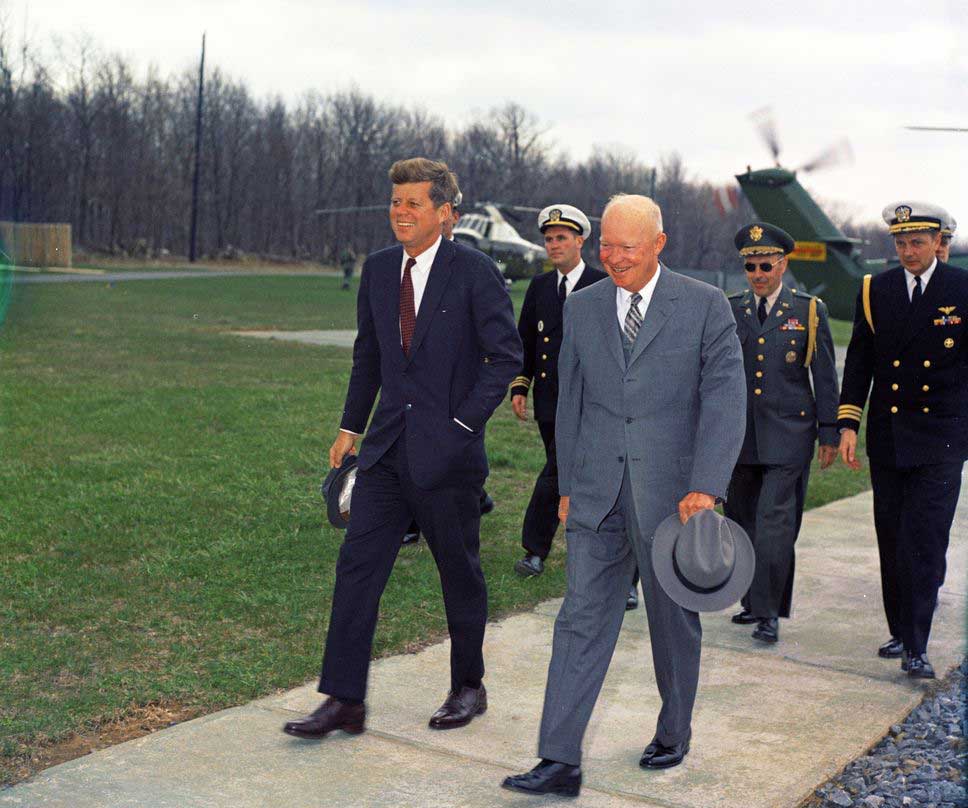Bay of Pigs

President Kennedy meets with President Eisenhower at Camp David April 21
President Kennedy inherited the CIA plan to send Cuban exiles to liberate the country. The CIA and the military convinced Kennedy that a plan to send a few thousand troops could succeed against a vastly superior force at Castro's disposal. The CIA and the military were counting on the President to approve direct US support once the invasion was under way. Kennedy, on the other hand, continually tried to limit US involvement. The result was the annihilation of the invasion force.
President Kennedy inherited the plans for the Bay of Pigs invasion from the Eisenhower Administration and so was forced to deal with the plan virtually from the moment he took office. Fidel Castro had started out as the liberator of Cuba from the corrupt Batista regime. Castro's victory was met with mixed feelings in Washington. Soon after taking control, Castro began nationalizing property and embracing Communism, thereby planting the seeds of a strategy to unseat him. The plan was premised on the idea that a popular uprising would commence against Castro once the invasion had been launched.
Kennedy was forced to choose between two very difficult options: 1) scrapping the plan entirely, which would entail disarming the Cuban rebels who had been trained in Guatemala by the CIA and then facing criticism that he was appeasing Castro; or 2) going along with a plan in which he did not fully believe, and about which he had strong misgivings as to the likelihood of success. Kennedy's advisors were divided. The CIA insisted that the plan would succeed; while the State Department warned of the perils of implementing the plan.
President Kennedy seemed drawn into the vortex of the ill-fated Cuban plan. On March 28, 1961, Arthur Schlesinger asked the President, what he thought of the plan regarding Castro. His answer: " I think about it as little as possible. " This was indicative of Kennedy's actions on the topics of Castro and Cuba. Kennedy's only insistence was that US involvement be as limited as possible. So in the end, Kennedy went along with a plan in which he had little confidence.
Those behind the plan to remove Castro were counting on the President agreeing to commit US troops, if needed. For his part, Kennedy was counting on solving the problem by allowing the invasion to be carried out by a few thousand Cuban exiles, while the military and the CIA were counting on the President to authorize overt US intervention.
There had been a number of stories in the press regarding the potential for a US-sponsored invasion of Cuba. When the President was asked, at an April 12th news conference, how far the US would go in helping anti-Castro forces to invade Cuba, he answered: " There will not be under any conditions, an intervention in Cuba by the United States Armed Forces. This government will do everything it can to make sure that there are no Americans involved in any actions inside Cuba. "
On April 17th, the invasion of Cuba began. The operation never had a chance. The initial bombing attack on Cuban military bases destroyed only three planes. The invasion had not been a surprise. Tens of thousands of soldiers, under the command of Castro, were all poised to respond to an attack.
There were many pleas for support, but Kennedy stuck to his position of no overt US support. As a result, all of the rebels were captured and the fiasco forever known as the " Bay of Pigs" would enter into the history books as a debacle, for which President Kennedy publicly took full responsibility.
 >
>